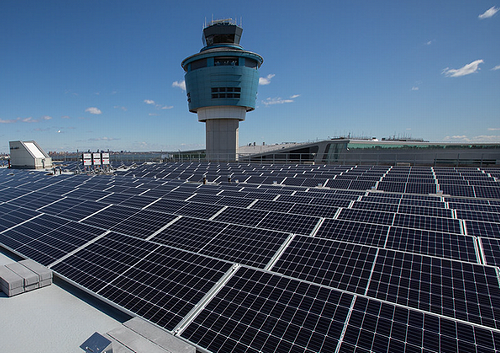
OXFORD, UK, September 13, 2022 (ENS) – Transitioning to a decarbonized energy system by around 2050 is expected to save the world at least US$12 trillion (£10.4 trillion), compared to continuing the current levels of fossil fuel use, according to a peer-reviewed study by Oxford University researchers, published in the journal “Joule” today.
The research shows a win-win-win scenario, in which rapidly transitioning to clean energy results in lower energy system costs than a fossil fuel system, while providing more energy to the global economy, and expanding energy access to more people around the world.
The study presents a “Fast Transition” scenario showing a realistic possible future for a fossil-free energy system by around 2050. It provides 55 percent more energy services globally than we have today by ramping up solar, wind, batteries, electric vehicles, and clean fuels such as green hydrogen made from renewable electricity.
Lead author Dr. Rupert Way, postdoctoral researcher at Oxford’s Smith School of Enterprise and the Environment, says, “Past models, predicting high costs for transitioning to zero carbon energy, have deterred companies from investing, and made governments nervous about setting policies that will accelerate the energy transition and cut reliance on fossil fuels. But clean energy costs have fallen sharply over the last decade, much faster than those models expected.”

Dr. Way has a PhD in mathematics. His current research focuses on energy system modeling, technology forecasting, innovation and technological change, portfolio analysis, decision making under uncertainty, and understanding strategies for accelerating the sustainable energy transition.
“Our latest research shows scaling up key green technologies will continue to drive their costs down – and the faster we go, the more we will save. Accelerating the transition to renewable energy is now the best bet not just for the planet, but for energy costs too,” Dr. Way explained.
“Although the Fast Transition happens quickly, it is still possible to replace the energy system without excessive stranding of capital,” the authors write.
“Lifetimes of large energy infrastructure projects typically range from 25 to 50 years, meaning that on average about two to four percent of capacity needs replacing in any given year. In addition, useful energy demand grows at two percent per year in all our scenarios. These two factors make it possible for key green technologies to replace most of the existing energy system in 20 years, and replace the remaining five percent within a few decades more, without necessarily stranding assets before their economic lifetimes,” they write.
The researchers analyzed thousands of transition cost scenarios produced by major energy models and used data on: 45 years of solar energy costs, 37 years of wind energy costs and 25 years for battery storage.
They found the real cost of solar energy dropped twice as fast as the most ambitious projections in these models, revealing that, over the last 20 years, previous models overestimated the future costs of key clean energy technologies versus reality.
“There is a pervasive misconception that switching to clean, green energy will be painful, costly and mean sacrifices for us all – but that’s just wrong,” says Professor Doyne Farmer, who leads the team that conducted the study at the Institute for New Economic Thinking at the Oxford Martin School.

“Renewable costs have been trending down for decades. They are already cheaper than fossil fuels in many situations and, our research shows, they will become cheaper than fossil fuels across almost all applications in the years to come. And, if we accelerate the transition, they will become cheaper faster. Completely replacing fossil fuels with clean energy by 2050 will save us trillions,” Farmer said.
The study showed the costs for key storage technologies, such as batteries and hydrogen electrolysis, are also likely to fall dramatically.
Meanwhile, the costs of nuclear power have consistently increased over the last five decades, making it highly unlikely to be cost competitive with plunging renewable and storage costs.
Professor Farmer said, “The world is facing a simultaneous inflation crisis, national security crisis, and climate crisis, all caused by our dependence on high cost, insecure, polluting, fossil fuels with volatile prices. This study shows ambitious policies to accelerate dramatically the transition to a clean energy future as quickly as possible are, not only, urgently needed for climate reasons, but can save the world trillions in future energy costs, giving us a cleaner, cheaper, more energy secure future.”
Since Russia’s invasion of Ukraine, the costs of fossil energy have skyrocketed, causing inflation around the world. This study, conducted before the current crisis, takes account of such fluctuations using over a century’s worth of fossil fuel price data.
The current energy crisis underscores the study’s findings and demonstrates the risks of continuing to rely on expensive, insecure, fossil fuels. The research confirms the response to the crisis should include accelerating the transition to low cost, clean energy as soon as possible, as this will bring benefits both for the economy and the planet.
The research is a collaboration between the Institute for New Economic Thinking at the Oxford Martin School, the Oxford Martin Programme on the Post-Carbon Transition and the Smith School of Enterprise & Environment at the University of Oxford, and SoDa Labs at Australia’s Monash University.
Featured image: Sunrise lights up the Rampion Wind Farm seen from the coast of Brighton, East Sussex, England, UK. April 23, 2018 (Photo by Dominic Alves)
© 2022, Environment News Service. All rights reserved. Content may be quoted only with proper attribution and a direct link to the original article. Full reproduction is prohibited.



